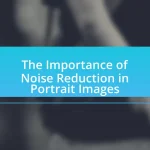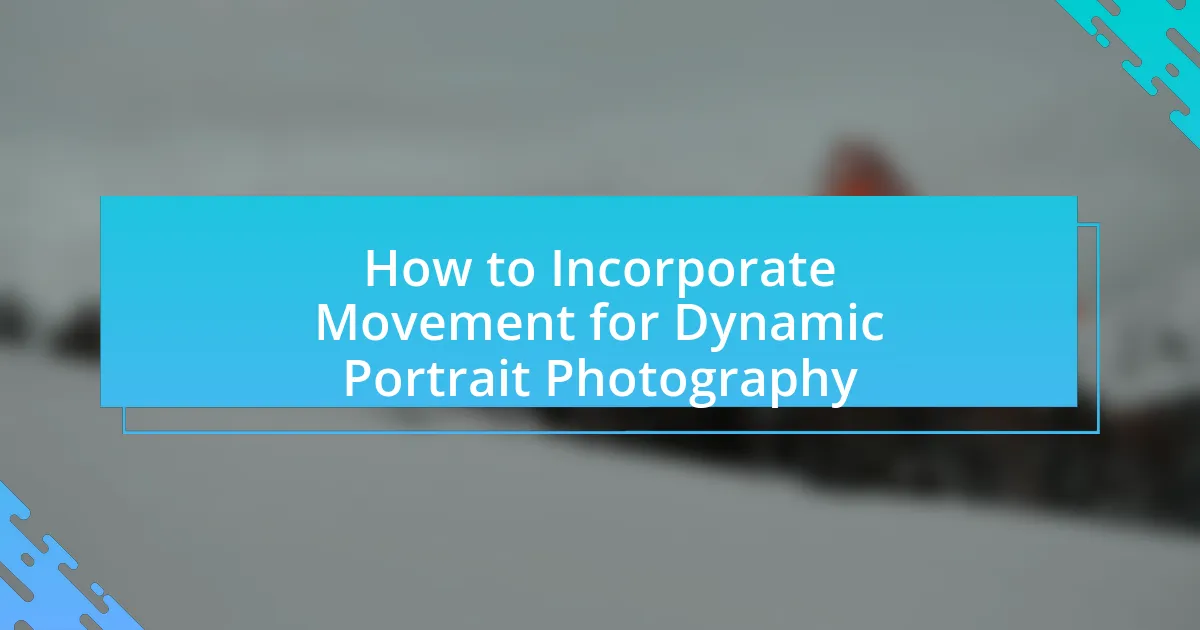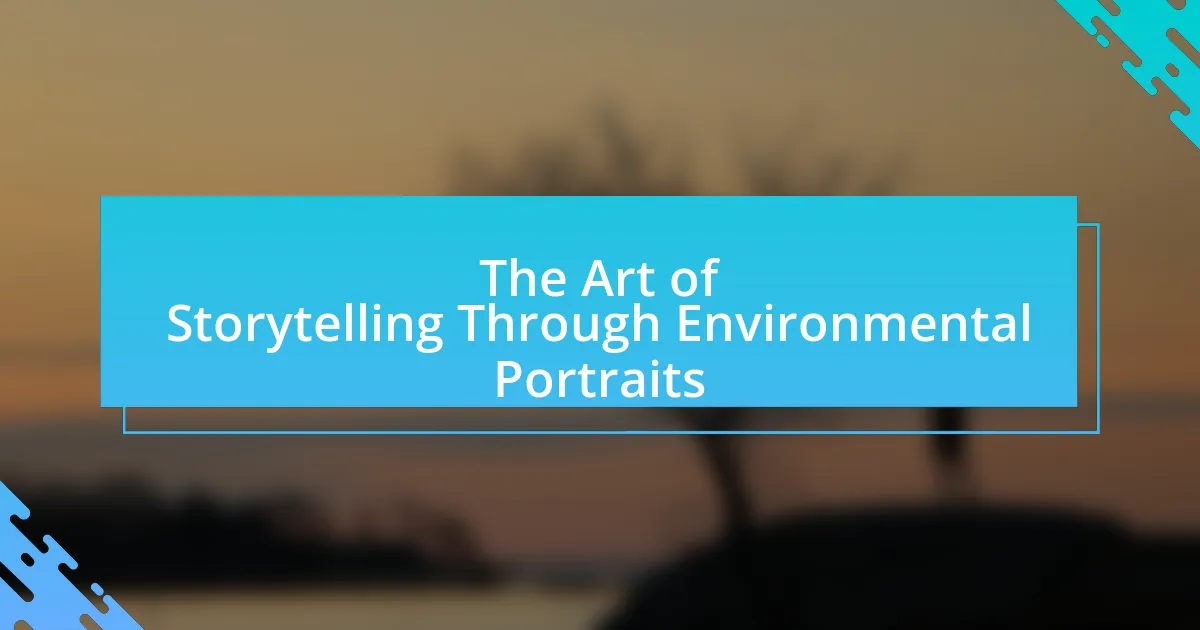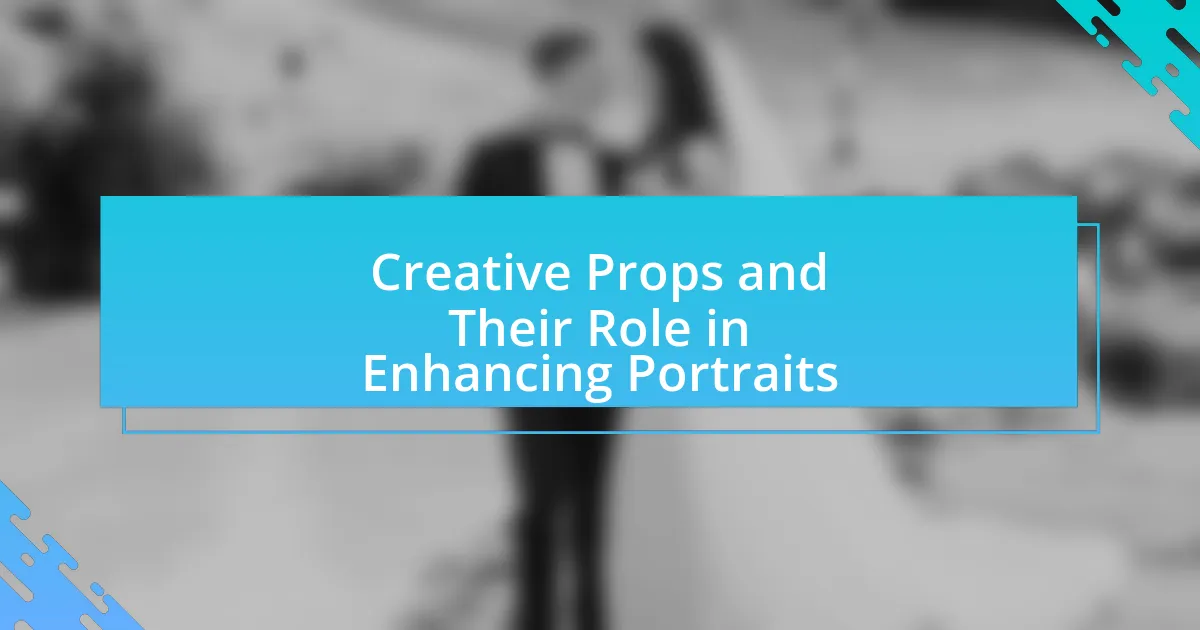The article focuses on the use of shadows and light in portrait photography, emphasizing their fundamental role in shaping a subject’s features and mood. It explores how different lighting techniques, such as natural and artificial light, influence the emotional impact of portraits, as well as the importance of contrast and direction in creating depth and dimension. Key topics include the effects of hard and soft light, the use of reflectors and diffusers, and practical tips for achieving dramatic portraits. Understanding these elements is essential for photographers aiming to enhance storytelling and viewer engagement through effective manipulation of light and shadow.
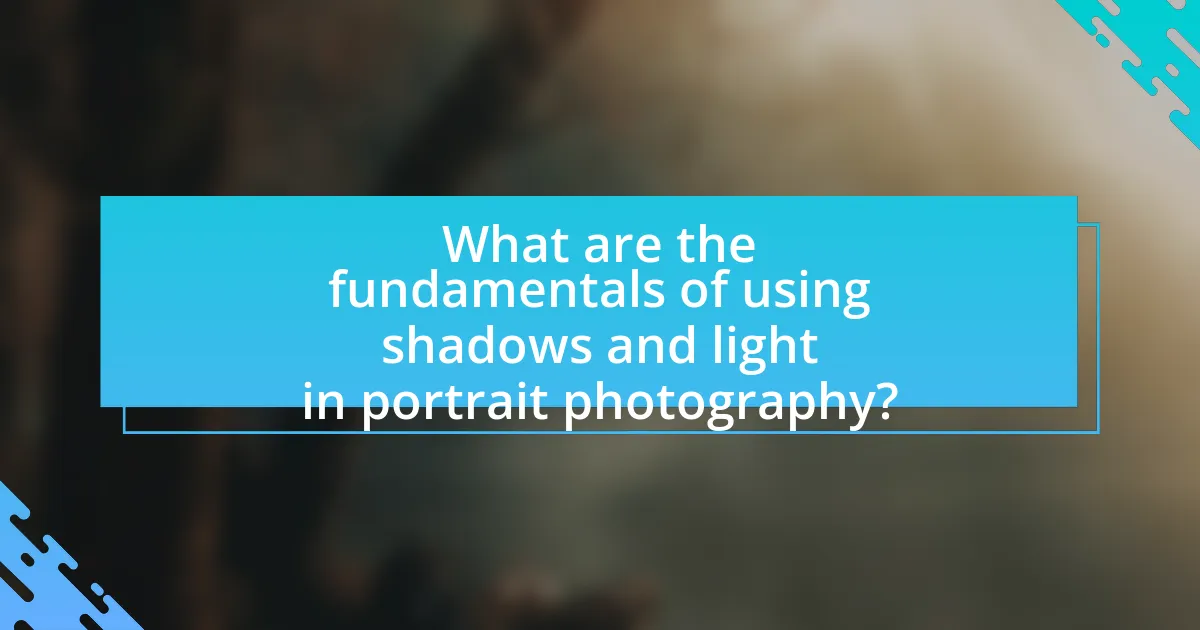
What are the fundamentals of using shadows and light in portrait photography?
The fundamentals of using shadows and light in portrait photography involve understanding the direction, quality, and intensity of light to shape the subject’s features and create mood. Directional light, such as side lighting, enhances texture and dimension, while soft light minimizes shadows and creates a flattering effect. The interplay of light and shadow can evoke emotions; for instance, high contrast can convey drama, while soft shadows can suggest intimacy. Studies show that lighting ratios, such as the 2:1 or 3:1 ratio of key light to fill light, significantly impact the visual outcome, allowing photographers to manipulate the subject’s appearance effectively.
How do shadows and light influence the mood of a portrait?
Shadows and light significantly influence the mood of a portrait by altering the perception of depth, emotion, and atmosphere. The interplay between light and shadow can evoke feelings of drama, intimacy, or tension; for instance, high-contrast lighting creates a stark, intense mood, while soft, diffused light tends to produce a calm and serene atmosphere. Research in visual perception indicates that shadows can enhance three-dimensionality, making subjects appear more lifelike and emotionally engaging. Additionally, the direction of light affects how features are highlighted or obscured, further shaping the viewer’s emotional response. For example, Rembrandt lighting, characterized by a small triangle of light on the subject’s cheek, often conveys a sense of mystery and depth, enhancing the overall emotional impact of the portrait.
What role does contrast play in creating dramatic effects?
Contrast plays a crucial role in creating dramatic effects by enhancing visual interest and emphasizing key elements within a composition. In the context of portraits, high contrast between light and shadow can evoke strong emotions, draw attention to facial features, and create a sense of depth. For instance, the use of chiaroscuro, a technique that employs stark contrasts between light and dark, has been historically utilized by artists like Caravaggio to convey mood and highlight the subject’s emotional state. This technique not only captures the viewer’s attention but also adds a layer of complexity to the visual narrative, making the portrait more engaging and impactful.
How can the direction of light alter the perception of a subject?
The direction of light significantly alters the perception of a subject by influencing how shadows and highlights define its features. When light comes from above, it creates shadows under the chin and nose, which can enhance the three-dimensionality of the face, making it appear more sculpted. Conversely, when light is directed from below, it can produce an eerie effect, emphasizing features in an unsettling way. Studies in photography demonstrate that side lighting can accentuate textures and contours, adding depth and drama to portraits. For instance, a study by Ansel Adams highlights how varying light angles can transform the emotional impact of an image, showing that the same subject can evoke different feelings based on light direction.
What are the different types of lighting techniques used in portrait photography?
The different types of lighting techniques used in portrait photography include natural light, artificial light, and mixed lighting. Natural light utilizes sunlight, often during golden hour, to create soft and flattering portraits. Artificial light involves the use of studio lights, such as strobes or continuous lights, which can be manipulated for desired effects. Mixed lighting combines both natural and artificial sources, allowing for creative flexibility and unique results. Each technique can dramatically influence the mood and depth of a portrait, making them essential tools for photographers.
What is the difference between hard light and soft light?
Hard light creates sharp, well-defined shadows and highlights, while soft light produces gentle, diffused shadows with gradual transitions. The distinction arises from the size of the light source relative to the subject; a small light source, such as a direct sunlight beam, results in hard light, whereas a larger light source, like an overcast sky or a softbox, generates soft light. This difference significantly impacts the mood and texture in portrait photography, as hard light emphasizes details and textures, while soft light flatters skin tones and reduces blemishes.
How can natural light be effectively utilized in portraits?
Natural light can be effectively utilized in portraits by positioning the subject near windows or outdoor settings during golden hour, which is the hour after sunrise or before sunset. This time provides soft, diffused light that enhances skin tones and reduces harsh shadows. Additionally, using reflectors can help bounce light onto the subject’s face, filling in shadows and creating a more balanced exposure. Studies show that natural light can improve the aesthetic quality of portraits, as it creates a more flattering and natural look compared to artificial lighting.
Why is understanding light and shadow essential for photographers?
Understanding light and shadow is essential for photographers because it directly influences the mood, depth, and composition of an image. Mastery of light allows photographers to highlight subjects, create contrast, and evoke emotions, while effective use of shadow adds dimension and interest. For instance, the Rembrandt lighting technique, which utilizes a specific interplay of light and shadow, is widely recognized for its ability to create a three-dimensional effect on a two-dimensional surface, enhancing the subject’s features. This understanding is supported by studies in visual perception, which indicate that well-managed light and shadow can significantly impact viewer engagement and interpretation of photographs.
How does mastering light and shadow enhance storytelling in portraits?
Mastering light and shadow enhances storytelling in portraits by creating depth, mood, and focus, which convey emotions and narratives effectively. The interplay of light and shadow can highlight specific features of the subject, drawing the viewer’s attention to key elements that express the subject’s personality or situation. For instance, Rembrandt lighting, characterized by a triangle of light on the subject’s cheek, evokes a sense of drama and intimacy, often used to tell a story of vulnerability or strength. Studies in photography demonstrate that portraits utilizing strong contrasts between light and shadow can evoke emotional responses, as seen in the works of renowned photographers like Ansel Adams, who emphasized the importance of tonal range in storytelling.
What common mistakes do photographers make regarding light and shadow?
Photographers commonly make mistakes such as not understanding the direction of light, which can lead to unflattering shadows on subjects’ faces. This lack of awareness can result in harsh lighting that flattens features or creates unwanted distractions. Additionally, many photographers fail to consider the quality of light; for instance, using direct sunlight can create overly harsh shadows, while soft light can enhance textures and details. Another frequent error is neglecting to control the exposure, which can either wash out highlights or obscure shadow details. Understanding these aspects is crucial for achieving dramatic and effective portraits.
How can photographers create depth and dimension using shadows and light?
Photographers can create depth and dimension using shadows and light by strategically positioning their light sources to cast shadows that enhance the three-dimensionality of their subjects. For instance, using side lighting can create strong contrasts between light and shadow, emphasizing the contours of a face or object, which adds visual interest and depth. Additionally, backlighting can create a halo effect around the subject, further separating it from the background and enhancing the perception of depth. Studies in photography demonstrate that manipulating light and shadow effectively can lead to more dynamic and engaging images, as seen in the works of renowned photographers like Ansel Adams, who utilized these techniques to create dramatic landscapes with pronounced depth.
What are the best practices for positioning subjects in relation to light sources?
The best practices for positioning subjects in relation to light sources involve placing the subject at an angle to the light to create depth and dimension. This technique enhances facial features and adds texture to the subject’s appearance. For instance, positioning the subject at a 45-degree angle to the light source can produce flattering shadows that define the cheekbones and jawline. Additionally, using diffused light, such as through a softbox or natural light on an overcast day, can minimize harsh shadows and create a more even illumination. Studies in portrait photography emphasize that the direction and quality of light significantly impact the mood and emotional tone of the image, reinforcing the importance of thoughtful subject placement in relation to light sources.
How can backlighting be used to create dramatic effects?
Backlighting can create dramatic effects by illuminating the subject from behind, which enhances silhouettes and adds depth to the image. This technique emphasizes contours and shapes, often resulting in a striking contrast between the subject and the background. For instance, when photographing a person against a sunset, the light outlines their figure, creating a visually compelling scene that draws attention to the subject’s form while obscuring details in the foreground. This method is widely used in portrait photography to evoke emotion and highlight the subject’s presence, as seen in works by renowned photographers like Ansel Adams, who utilized backlighting to enhance the drama in his landscapes.
What techniques can be employed to control shadows in a portrait?
To control shadows in a portrait, photographers can employ techniques such as adjusting lighting angles, using reflectors, and modifying light sources. Adjusting lighting angles involves positioning the light source at different heights and directions to create softer or harsher shadows, which can dramatically alter the portrait’s mood. Using reflectors helps bounce light back onto the subject, filling in shadows and creating a more balanced exposure. Modifying light sources, such as using diffusers or softboxes, softens the light, reducing the intensity of shadows and creating a more flattering appearance. These techniques are widely recognized in portrait photography for their effectiveness in shadow management.
What tools and equipment can enhance the use of shadows and light in portraits?
To enhance the use of shadows and light in portraits, photographers can utilize tools such as reflectors, diffusers, and artificial lighting equipment like strobes or continuous lights. Reflectors help bounce light onto the subject, softening shadows and adding highlights, while diffusers soften harsh light sources, creating a more flattering illumination. Artificial lighting equipment allows for greater control over light direction and intensity, enabling the photographer to sculpt shadows effectively. For instance, using a softbox with a strobe can create a soft, even light that enhances facial features without harsh shadows. These tools are essential for achieving dramatic effects in portrait photography, as they allow for precise manipulation of light and shadow to create depth and mood.
How do reflectors and diffusers impact lighting in portrait photography?
Reflectors and diffusers significantly influence lighting in portrait photography by controlling the quality and direction of light. Reflectors bounce light onto the subject, filling in shadows and creating a more balanced exposure, which enhances facial features and adds depth. For instance, using a silver reflector can produce a brighter, more specular light, while a white reflector offers a softer, more diffused effect. Diffusers, on the other hand, soften harsh light sources, reducing contrast and creating a more flattering illumination on the subject’s skin. This is particularly important in portrait photography, where even lighting can minimize blemishes and enhance the overall aesthetic. The combination of reflectors and diffusers allows photographers to manipulate natural or artificial light effectively, achieving desired moods and tones in their portraits.
What role do artificial lights play in creating dramatic portraits?
Artificial lights are essential in creating dramatic portraits as they allow photographers to manipulate shadows and highlights, enhancing the subject’s features and mood. By controlling the intensity, direction, and color of the light, photographers can create a sense of depth and dimension, which is crucial for dramatic effect. For instance, using a single light source can produce strong shadows that add tension and intrigue to the portrait, while soft lighting can evoke a more subdued atmosphere. Studies in photography demonstrate that the strategic use of artificial lighting can significantly alter the perception of a subject, making it a vital tool for artists aiming to convey emotion and narrative in their work.
What are some practical tips for achieving dramatic portraits with shadows and light?
To achieve dramatic portraits with shadows and light, utilize strong directional lighting to create contrast and depth. Position your light source at an angle to the subject, which enhances textures and shapes, resulting in more dynamic images. Experiment with different light modifiers, such as softboxes or reflectors, to control the intensity and quality of light, allowing for varied shadow effects. Additionally, consider the background; a darker backdrop can amplify the subject’s features and the interplay of light and shadow. Using these techniques, photographers can create striking portraits that evoke emotion and intrigue.





